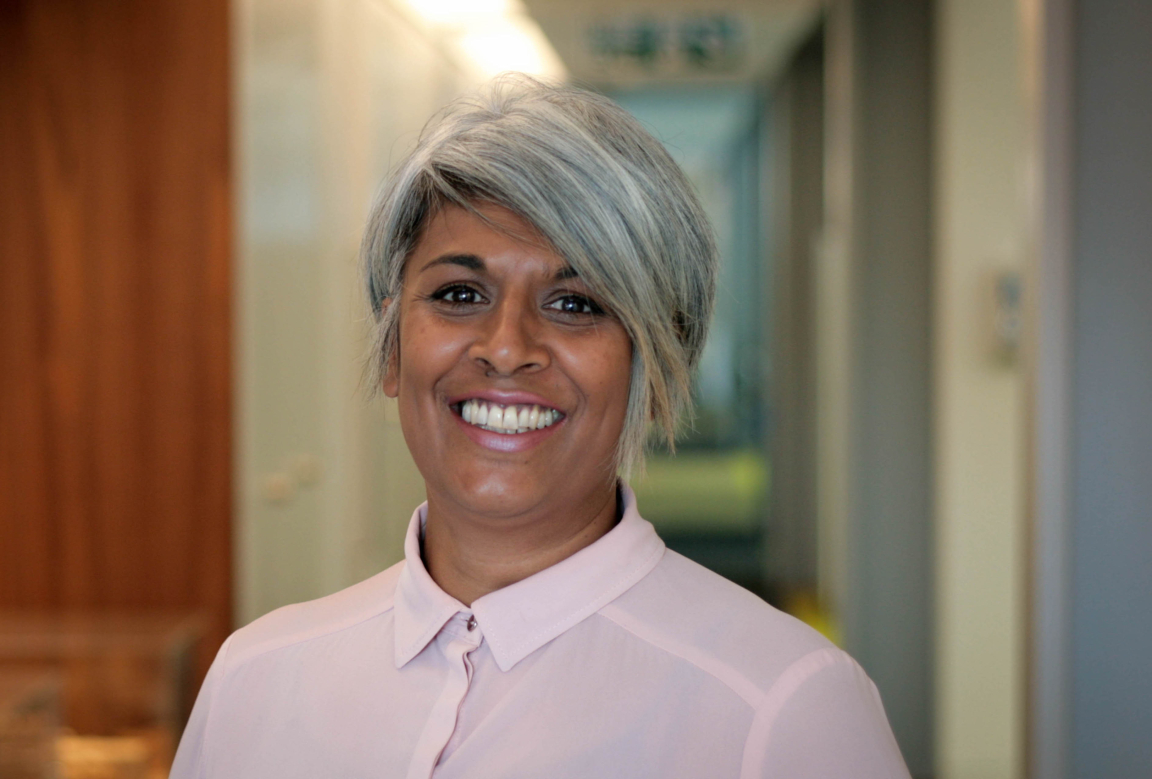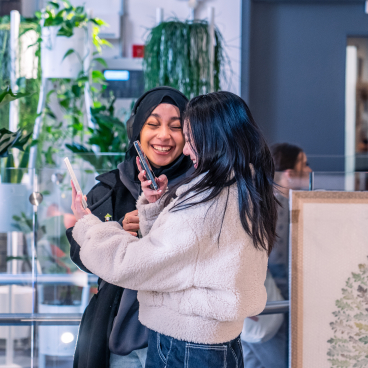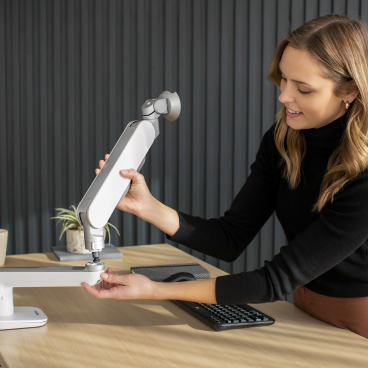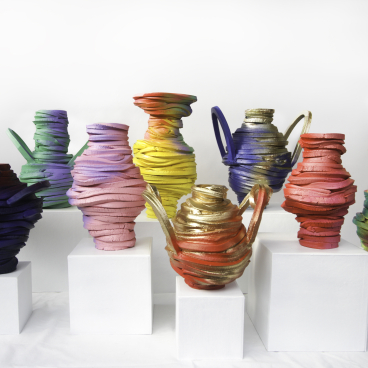Chithra Marsh, director at Buttress & former national chair of Women in Property, on embracing social value, EDI & culture to fuel innovation.

When speaking to Chithra Marsh, it’s impossible not to feel inspired. Her genuine enthusiasm for supporting and championing others is infectious. And while some may throw around acronyms such as EDI (equality, diversity, inclusion) because they’re an industry ‘hot topic’, it’s clear to see that Chithra’s interest in what this truly entails runs deep. And that comes from places both professional and personal.
While candidly chatting through her experiences as both director at Buttress – a leading design studio providing architecture, urban design, interiors, and conservation design – and, up until very recently, national chair of Women in Property – an association that seeks to support and provide opportunities to its members, Chithra is conscious to give credit where it's due - turning the spotlight onto those she works alongside, constantly mentioning the names of her colleagues and collaborators, and insisting it’s teamwork – and the coming together of people - that helps turn her values into action.
From community engagement, to putting people at the heart of high street reinvigoration, and why she’s no longer afraid to be herself in the workplace, here, Chithra shares her thoughts around how social value, EDI, and culture - the theme of her tenure at Women in Property – all interconnect. And actually, as well as being the right thing to do by people, can help drive the bottom line for businesses too.
Firstly, tell us more about your role as director at Buttress
“Buttress is 85-strong now, with studios in Manchester and Leeds. As a company, we’re B Corp certified – we’re committed to ethical practice. And we’re currently looking at every element of how the business runs within the B Corp remit to maximise our efforts in each of the segments of it. Within that, it’s about devolving some responsibility so it’s not just board directors that are responsible but people all across the company are getting involved. This means that everyone is contributing to the betterment of Buttress.
“We’ve gone through a huge exercise in assessing our purpose and values over the past 4 years – it was instigated in lockdown and has continued to build from there. As part of this we employ Sallie Haydock from Unify Partnership, who runs an insights discovery programme. This involves every new team member of Buttress completing a questionnaire, which produces an in-depth report on our different working styles. These insights help us all understand one another a bit more so we can communicate more effectively.
“Pre lockdown we were a team of around 45, so we’ve grown massively and realise a lot of care and attention needs to go into keeping hold of our values, and making sure they are translated properly.
“The beauty of Buttress is the whole Manchester team is based on one level so we’re able to share our expertise across the board. We’re also redeveloping our office to allow us more space to collaborate because that’s what our people are coming to the workplace for. We have a flexible arrangement for team members, and we allow working from not just home but ‘elsewhere’ – it could be a café, or here (Material Source Studio).
It’s about what’s required from the individual and their team and tailoring their environment to the needs of the task.
“We also have a health and wellbeing programme, called B Well, and an EDI programme, called B Proud. A lot of our social value work at Buttress goes into time spent on programmes internally, and externally, with work done in schools, for example. We collaborate with a company that measures all our social value, and over the last two-years we contributed over £500,000 worth, and only 5% of this was donations – the rest was hands-on.
“From a client and sector perspective we work in a number of sectors, with residential and heritage being our largest. We work with all different types of client, within both public and private sectors. And our heritage background intertwines with arts and culture – so we work with museums, galleries, and our faith team has worked on cathedrals, such as Lincoln. We have a focus on retrofit and our sustainability team has developed a carbon calculator. To break down silos between project teams, we have a BD Strategy Group, which invites representatives from each sector team to present to the wider group – that way we all know what one another’s working on in more depth.
“I feed in on the social values side of things alongside my colleague Kim – we lead on the community values section of the B Corp wedge, if you like, and we also lead on community projects for clients – from switching the purpose of a space to regenerating the high street. We’re trying to broaden this to not just being on a Local Authority level but promoting good social value to private developers too.
“It’s not just about repurposing a building either, but regenerating the whole surrounding area. And that goes for not only heritage buildings – it can be something not seen as a heritage asset but that’s equally as valuable within the city centre, or town, that’s empty, or will be soon, to add something to the overall architectural mix. It’s fluid.”
When it comes to clients, are they always keen to engage with local communities?
“We encourage this through an engagement programme, which runs alongside the development schedule. Sometimes we’ll do this ourselves, but we also work a lot with a company called PLACED in Liverpool. They offer consultation and engagement but also run an academy, which we sponsor every year, and that works to promote architecture and design to school children and young adults. It obviously all depends on the client and their audience, and what we’re developing for them.”
Do clients always ask for an element of EDI to be considered within schemes/developments?
“Some ask, some don’t. Personally, I feel strongly about it. Everything we create would be worthless if nobody was using it. For me, it’s not just about consulting a homogenous community and tailoring the findings. You have to ask what the make up of that community is and understand it. What’s its cultural diversity? It’s a cliché that one size doesn’t fit all, but it’s true.
“When I came into the industry, it wasn’t a thing. I found for the first two decades of my career that I struggled to see where I fit. I’ve been acknowledging EDI myself for a long time – I was an ambassador for PLACED when they started, and now I’m a strategic ambassador, because I really support them and believe in what they’re doing. They’ve been doing this since long before anyone else.
"When I arrived at Buttress, I felt I was able to spread my wings. And at the same time, the world caught up.
Suddenly, everyone’s talking about people and the planet.
"It could be about timing, and the world being ready, but I spent a long time wondering who I was an architect.
"And now I know exactly who I am. And that’s why my team are the community team, that’s why we work with Local Authorities. However, the finances are tight and it’s not an infinite workstream, so we need the next stage being promoting to the private sector. Even when working with Local Authorities there is normally a stretch of property or a building that is owned by someone else, it’s a difficult thing to do when you consider getting the buy-in of everyone.
“We’re working on a projects in Cumbria, grant funded from Levelling Up funds such as, the Future High Streets, HS HAZ, and Towns Fund. There are some lovely things we’re delivering as part of that, including converting an old cinema into a community hub and music venue with artist studios – there’s even a secret garden at the back.”
As well as being a director at Buttress, you have recently come to the end of a three-year tenure as vice, then national chair of Women in Property – what did you learn in your time there?
“I started off being vice chair, and then for the past year I’ve been national chair. And now I’m in my former national chair role. The theme for my tenure was social value, and promoting it to a broader audience, talking about EDI and culture.
“I’ve spent a lot of my career pretending I’m not Indian. I have heritage that existed indoors at home, but that wasn’t something for outside. But I’ve watched the world change, the rhetoric change, and now I feel it can be celebrated – I don’t need to conform.
“Being able to spread my wings and concentrate on social value has allowed me to be braver to talk about, and stand up for, my peers – I’ve learnt not to be afraid to be vocal. When you’re part of a group that’s not very well represented, you get asked to do this as well. But I will only talk about the things that I’m interested in and believe in – I won’t push other peoples’ agendas.
"Women in Property was a massive learning curve in opening my eyes to the diversity of lived experience of others. We all hold unconscious bias, and I only know my own circumstances.
Just because you’re culturally diverse it doesn’t mean you know about other peoples’ backgrounds or individual experience. I now ask a few more questions when I meet someone than I used too.
“This has helped me in my role as an architect, especially in terms of the engagement piece. It’s not just demographics and geography, it’s also understanding the deeper make-up of that so you don’t lose it, or wash it away. In the UK our communities are complex. We have such rich culture. It can be very easy to gentrify. Or make developments look the way we think they should look. But the point is these areas can be so animated in their own right - they may just need cleaning up a bit. Assessing the level of intervention is so important – the pride of the community could be raised without putting in a load of stuff they don’t want or need.
“This affects everything from high street to housing, and how they are celebrated through arts and culture. When you think about repurposing old buildings, you need to think about place and people – what’s the purpose of repurpose? We don’t always do enough of asking ‘why’, and there’s a lot we take for granted.
“We can also apply this logic to sustainability. Other countries around the world are experiencing things such as flooding – are we looking to the people that live there to see how they are dealing with it, and adapting? Is there anything we can learn? Through my year as national chair at Women in Property, I became aware that we need to apply caution when looking at sustainability – making sure our efforts there don’t contradict the social agenda.
Getting on a plane isn’t particularly popular now, for example, but if you don’t go further afield, your point of reference can become very small. So what you end up doing is only learning from the places that you can get as far as – or Google.
“I was part of the selection committee for the British Pavilion at the Venice Biennale in 2023, and as part of this I was invited to go for the opening - attending this was a lightbulb moment for me. The theme was cultural rituals that have been lost by diasporas communities that have come into the UK. But these rituals are connected to innovation, they offer a depth of understanding, and through learning about them we can stop using terminology like ‘underdeveloped countries’ when referring to those not in the western world. By saying these things, it makes them seem lesser. They’re not underdeveloped, they’re just countries.
“With the whole culture and social values piece, I’m not trying to preach, but I want to share what I’ve seen and highlight how blinkered we can sometimes be. Look further afield because you might find something really interesting. And while I’m not saying good ideas don’t come from here, it’s about valuing them as much as those from other places - on the same level.
“I feel all of this has come together at exactly the same time as me feeling a bit braver to say it.”





